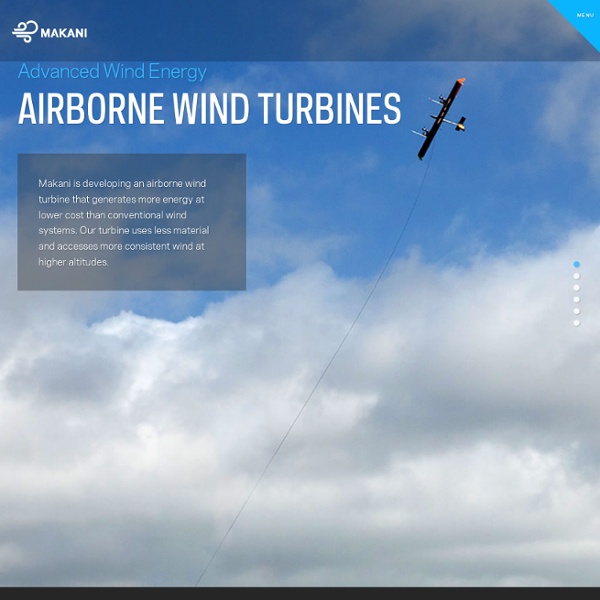



Eolien : l’avenir se joue en altitude L’un des principaux défauts des éoliennes classiques est leur difficulté à exploiter le vent de manière efficace. Ce dernier est instable à proximité de la terre et relativement peu puissant. Depuis des années, les éoliennes sont de plus en plus grandes afin d’être plus efficaces mais les structures atteignent peu à peu leurs limites. L’idée d’ingénieurs est donc d’aller chercher le vent là où il est potentiellement le plus exploitable : à 400 m d’altitude voire jusqu’à 1.000 m pour certains prototypes. A cette hauteur, le vent souffle à une vitesse comprise entre 100 et 350 km/h et de manière constante. Des premiers prototypes encourageants Concrètement les projets ne sont qu’à leurs débuts. Le deuxième prototype ressemble d’avantage à un ballon géant gonflé à l’hélium et muni d’une turbine. Une énergie disponible partout et moins cher Les avantages des éoliennes volantes sont nombreux. Des risques limités Très vite se posent des questions de sécurité. Arnaud Martin
Google's Makani: From Regulatory To Technical To Wildlife Challenges Clean Power Published on February 19th, 2014 | by Mike Barnard Almost a year ago, Google took a 100% ownership position in Makani, an airborne wind energy company. It had previously held a $15 million position in the company, but after the tragic death of one of its founders, Makani’s future was less certain. Now it has deep pockets in Google X, the division devoted to breakthrough technologies. So, how likely is Makani to disrupt wind generation? Makani’s 20 KW (average output when flying under optimal conditions) working prototype. Close assessment of Makani’s public documentation shows that their approach to airborne wind energy has several serious challenges, some in common with other airborne wind energy approaches, some unique to Makani: It is unlikely that they will be able to put up more than a handful of onshore wind farms given the restrictions, but offshore in tropical and subtropical climates is somewhat more promising. What is the Makani model? But it gets worse for Makani.
ARCHIVED - CBD-28. Wind on Buildings - IRC - NRC-CNRC Information found on this page has been archived and is for reference, research or recordkeeping purposes. Please visit NRC's new site for the most recent information. Archived Content Information identified as archived on the Web is for reference, research or recordkeeping purposes. It has not been altered or updated after the date of archiving. Web pages that are archived on the Web are not subject to the Government of Canada Web Standards. Please note This publication is a part of a discontinued series and is archived here as an historical reference. Originally published April 1962. W. In the past very simple concepts have frequently been used in estimating live loads for structural design. Wind loads have become particularly significant because of the increasing number of high-rise buildings. Some tall buildings that extend into regions of high wind velocity have swayed excessively in strong winds. Development of Wind Velocity Profile Figure 1. Turbulence in Surface Winds Figure 2. * D.
Are airborne wind turbines a plausible source of cheap clean energy? | barnard on wind One of the interesting things about wind energy is that while the market has spoken loudly and clearly about what makes economic sense for wind generation, every week there’s another news story on wind generation innovations such as relatively ineffective vertical-axis wind turbines that are going to replace horizontal-axis, three-blade wind generators. An ongoing area of enthusiasm and to date fruitless investment is the area of airborne wind generation. Numerous companies have concepts or designs which are hyped as replacing the roughly 250,000 iconic white, tri-blade towers around the world today. Airborne wind energy has been in research and development for 70 years without generating any useful amounts of electricity in a production capacity anywhere. What is airborne wind energy? Airborne wind energy is based on the long-known reality that winds get stronger and more reliable the higher off the ground you go. 1. 2. Tethers present another class of problems. 3. 4. 5. 6. Summary:
How significant is bird and bat mortality due to wind turbines? | barnard on wind Wind turbines are often criticized for killing birds and bats. Fights against siting wind turbines in bird migration corridors or in bird habitat are frequent. Highly inflammatory language is used by anti-wind energy advocates such as ‘bird mincer’, ‘bird blender’ and ‘eagle killers’. Outlandish numbers of deaths are often attributed to them. How significant is the mortality of wind turbines upon birds and bats? Short Answer: Replacing all fossil fuel generation with wind turbines world wide would save tens of million birds lives annually. Long Answer: Overall, wind energy has the least impact on wildlife of any form of energy generation with the possible exception of solar. or These are the big threats. What about bats?